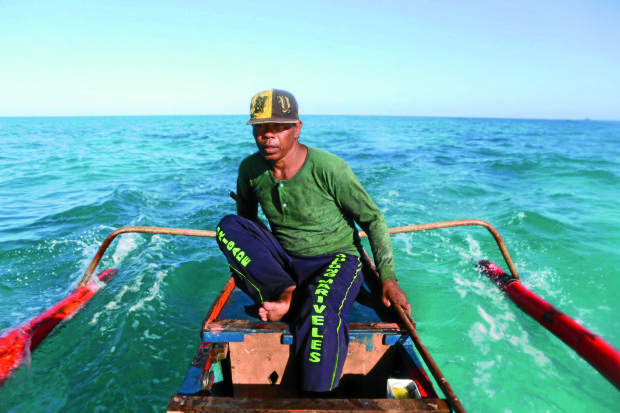China to build environmental monitoring station on Panatag

TESTING THE WATERS. Fisherman Mar Pelayo returns to the fishing grounds of Filipinos unaware that not all is calm on Panatag Shoal with China planning to build a structure there. PHOTO BY REM ZAMORA
BEIJING — China plans to build the first permanent structure on a South China Sea shoal at the heart of a territorial dispute with the Philippines, in a move likely to renew concerns over Beijing’s robust assertions of its claims in the strategically crucial waterbody.
The top official in Sansha City that has administered China’s island claims since 2012 was quoted by the official Hainan Daily newspaper as saying that preparations were under way to build an environmental monitoring station on Panatag Shoal, known internationally as Scarborough Shoal, off the coast of Zambales province in the Philippines.
The preparatory work on the stations and others on five other islands in the strategically vital waterway was among the government’s top priorities for 2017, Sansha Communist Party Secretary Xiao Jie was quoted as saying in an interview published in the paper’s Monday edition seen online Friday in Beijing.
No other details were provided.
The Philippines’ Department of Foreign Affairs said on Friday it could not comment on Xiao’s remarks, as it had yet to verify the Hainan Daily report.
Seized by China
Beijing seized tiny, uninhabited Panatag Shoal in 2012 after a two-month standoff with Philippine vessels.
Taiwan also includes the island within its South China Sea claims that largely overlap with those of China.
The other stations mentioned by Xiao would be situated on features in the Paracel island group that China has controlled since seizing parts of it away from Vietnam in 1974.
Arbitral ruling
China’s construction and land reclamation work in the South China Sea have drawn strong criticism from the United States and others, who accuse Beijing of further militarizing the region and altering geography to bolster its claims.
China says the seven man-made islands in the disputed Spratly group, which it has equipped with airstrips and military installations, are mainly for civilian purposes and to boost safety for fishing and maritime trade.
Prior to the announcement, South China Sea tensions had eased somewhat since Beijing erupted in fury last year after a Hague-based arbitration tribunal ruled on a case filed by the Philippines.
The verdict invalidated China’s sweeping territorial claims and determining that China violated the rights of Filipinos to fish at Panatag Shoal.
China has since allowed Filipino fishermen to return to the shoal following President Duterte’s calls for closer ties between the countries, but it does not recognize the tribunal’s ruling as valid and insists it has historical claims to almost the entire South China Sea, through which an estimated $5 trillion in global trade passes each year.
Panatag has no proper landmass and any structure on it would likely have to be built on stilts.
The shoal forms a triangle-shaped lagoon of rocks and reefs running for 46 kilometers, with its highest point just 1.8 meters above water at high tide.
Known in Chinese as Huangyan Island, it lies about 200 km west of the main Philippine island of Luzon, and about 600 km southeast of China.
Red line
US diplomats have said privately that reclamation work on the shoal would be seen as crossing a red line because of its proximity to the main Philippine islands and the threat it could pose to US and Filipino military assets.
During his Senate confirmation hearing for secretary of state, Rex Tillerson compared China’s island-building and military deployments to Russia’s 2014 annexation of Crimea, and suggested China’s access to the islands should not be allowed.
The United States says China has reclaimed more than 1,295 hectares of land in the area.
The topic is likely to be high on the agenda when Tillerson visits Beijing for talks with top officials on Saturday and Sunday.
Benham Rise
Chinese Vice Premier Wang Yang was visiting the Philippines, just days after President Duterte said on Monday that he had told the military to assert Philippine ownership of Benham Rise off the country’s northeastern coast where Chinese survey ships were spotted last year, in a discovery that alarmed Philippine defense officials.
China, the Philippines, Vietnam, Taiwan, Malaysia and Brunei have long contested ownership of the South China Sea, which straddles one of the world’s busiest sea-lanes and is believed to sit atop vast deposits of oil and gas. —AP and Jocelyn R. Uy
For comprehensive coverage, in-depth analysis, visit our special page for West Philippine Sea updates. Stay informed with articles, videos, and expert opinions.